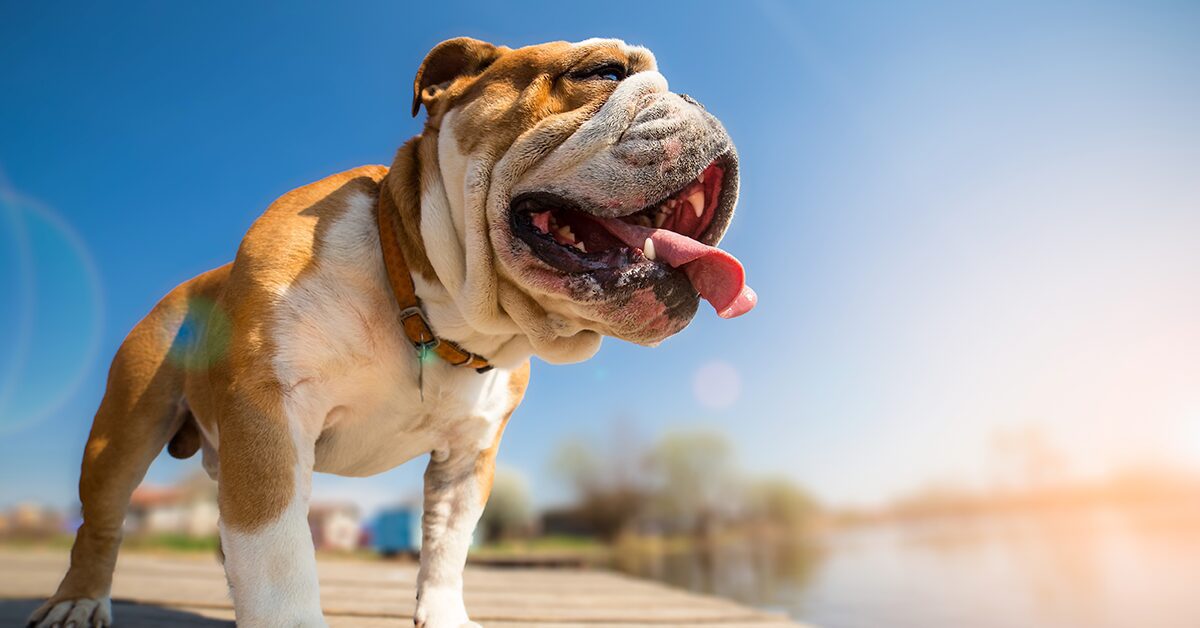Dogs love being outside. Whether they’re sitting on your patio and feeling the sun’s warmth, or running around your backyard, being outside is where they feel free to roam and explore. As the weather gets nicer and summer approaches, odds are you and your pup will be spending more time outdoors – which means more exposure to the sun.
Humans take necessary precautions to protect themselves from sunburn. As a devoted pet parent, you may be wondering: Can dogs get sunburn? Yes, just like their pet parents, dogs get sunburns, too! It’s relatively easy to prevent and treat doggie sunburns, and certain safety measures can lower your pup’s risk of developing serious sun-related medical issues. Here, we have outlined exactly how dogs develop sunburns plus safety tips for preventing a sunburn when you’re outside playing with your pup.
What causes sunburns in dogs
Sunburns occur when dogs are overexposed to UV rays from the sun, making their skin tight, red, and tender. Dogs can get sunburn when they spend too much time in direct sunlight, after long hours spent outdoors or even in a sunny spot near a window indoors. Even though sunburns are more common in the summertime, dogs can still develop sun damage in the winter or even on cloudy days.
Signs of sunburns in dogs
While we know the answer to can dogs get sunburn, what part of a dog’s body burns when exposed to the sun’s rays? Dogs tend to get sunburns in areas where they have little to no fur, like around their nose and ears. Belly sunburns can even occur when the sunlight reflects up from the pavement, affecting dogs with short legs, like Corgis and Dachshunds. Aside from the obvious sign of redness directly on your dog’s skin, their skin will be tender to the touch. Other signs of sunburns in dogs include:
- Dry, cracked, or curled edges of a dog’s ears
- Hair loss
- Fever
- Skin ulcers/blisters
- Skin infections/peeling
- Abnormal growths or dark discoloration on a dog’s skin (skin cancer)
- Vocalization of pain when touched or when moving
Which dog breeds are at risk for developing a sunburn?
Some dogs are more at risk for sunburn than others. Hairless breeds are the most prone to getting burns from sun exposure. Lighter-colored dogs and dogs with short hair, such as Boxers, Xoloitzcuintlis, and Poodles with lighter fur are at a higher risk for sunburn and need sun protection when outside for long periods of time. Dogs with white or thin coats and light-pigmented (pink) skin, noses, and eyelids are also at a higher risk for sunburn, including Border Collies, Whippets, Dalmatians, and white Pit Bulls, and any other dog with light or white pigment on their skin. Albino dogs, who have white fur and lack any pigment in their skin at all, are at the highest risk. While fair-colored and thin-furred dogs are at higher risk of sunburn, this doesn’t mean dogs with thick dark coats are not at risk.
Medical conditions and other circumstances may also put your pup at greater risk for developing sunburn. Dogs with scar tissue who have recently undergone surgery and had fur shaved for skin exposure, dogs with autoimmune diseases, dogs with hair loss from endocrine disorders, and dogs that suffer from genetic defects need to be carefully monitored while outdoors and in direct sunlight. Dogs who experience hair loss from seasonal shedding that causes their coats to become very thin may also be at greater risk for sunburn.
Pet Pro Tip: Illnesses won’t wait to happen. You shouldn’t wait to enroll in pet insurance. From common parasite infections, to costly hereditary illnesses, pet insurance is worth it and can cover crucial eligible treatment your pet may need for their unexpected accidents and illnesses. Find out how pet insurance works, what pet insurance covers, and choose a plan today.
How to protect and prevent sunburns in dogs
Sunburn is as painful and damaging to dogs as it is to humans, and may even take several days to subside and fade. Dogs who regularly develop sunburn are more at risk for serious skin diseases, like a cancer called squamous cell carcinoma, so it’s important to understand the measures you can take to prevent sunburns in dogs.
The easiest way to protect your pup from getting sunburned is avoiding letting them out for long periods of time when it’s the most sunny. Depending on the region where you live, this can mean avoiding playtime or long outings around midday, or 10 a.m. – 4 p.m.. If your pup does go out during this time, be sure to keep them in the shade and make sure your pup has plenty of water. This can help protect your dog from developing heatstroke and other illnesses from sun exposure.
Dogs can use SPF sunscreen to protect from sunburn, but you’ll want to stay away from human sunscreen. Be sure to only use dog-safe sunscreen. Check with your veterinarian first about which dog-friendly sunscreen they recommend and how to apply it correctly. Not all sunscreens are safe for pets and may contain harmful ingredients, like zinc oxide, that can cause your pup to vomit and experience other gastric problems. Avoid spray sunscreens as this can easily end up in your pup’s eye and cause further irritation. Ultraviolet and UPF-protective clothing for dogs can be a safe and practical way to protect high-risk dogs when outdoors. However, you will still need to protect your dog’s most vulnerable areas, such as their ears, nose, tail, belly, and exposed skin near the hind legs.
How to treat sunburns in dogs
Sunburn in dogs can be treated topically by using aloe vera, witch hazel, or coconut oil, as these soothing products won’t sting your dog’s sensitive skin. Cold compresses or ointments on the affected area can also help your dog feel better.
If you suspect your dog has a sunburn, be sure to contact your veterinarian for a proper diagnosis so they can recommend a course of treatment. Most of the time, sunburn in dogs can be treated at home, but more severe cases may need to be treated at the veterinarian clinic. If the burn is severe, your veterinarian may recommend treatment with a cortisone product to prevent further inflammation. They may also prescribe antibiotics if the burn starts to look infected. If your dog appears to be picking or chewing at the affected area, your veterinarian may also recommend a cone or other blocking device to curb this behavior.
Just like their pet parents, dog’s enjoy the warmth of the sun. Lying in the sun feels great for them, and can even help regulate their body temperature. So, it’s important to keep them protected when exposed to the sun’s harmful rays. If your dog does develop a sunburn and needs medical attention, Pumpkin Dog Insurance plans can help cover eligible vet bills for treatment, so you can say “yes” to the best care pawsible.




